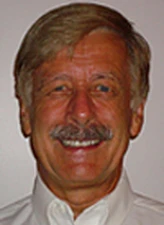Martinus Th. (Rien) van Genuchten

The 2010 John Dalton Medal is awarded to Martinus Th. (Rien) van Genuchten for outstanding contributions to the understanding of flow and transport processes in the unsaturated zone.
Rien van Genuchten developed an exemplary career in soil hydrology for the past 35 years, with most of his dedicated work conducted at the US Salinity Laboratory in Riverside, CA, for about 30 years. Because of his highly cited research on the development of basic theory of water flow and solute transport in unsaturated soils, the parallel derivations of idealized analytical solutions and development of innovative numerical techniques, he is among the premier hydrologists in the world today.
Because of the highly non-linear nature of flow and transport processes in the unsaturated zone, quantitative tools for analysis of this zone have developed only slowly. The fact is that the scientific contributions of van Genuchten in the early stage of his career have been major breakthroughs, allowing further advances of unsaturated zone hydrology, and without which the current state-of-affairs of the science today would not have been possible. Perhaps most clearly illustrating van Genuchten’s impact on science, is the highly cited article on ‘A Closed-Form Equation for Predicting the Hydraulic Conductivity of Unsaturated Soils (Soil Sci. Soc. Amer. J. , 1980, Vol. 44(5), pages 892-898), which has been cited 3,790 times (January ’09).
More than 20 of his research papers are cited more than 100 times. Using data from the ISI Web of Knowledge, van Genuchten’s average citation is 50, whereas his H index is 43.
In addition to developing parametric soil hydraulic models that are universally used in hydrological flow models across disciplines for a large number of applications around the globe, in the 1980’s van Genuchten with his colleagues was among the first to understand and apply inverse methodologies to estimate flow and transport parameters by matching experimental with model solutions. Whereas his early work in this area was applied to a wide variety of transport problems for a wide range of soil properties and contaminants, using analytical solutions to transport, his later work embedded his parameter estimation approaches to numerical models. Most evident of his inverse modelling contributions started when he attracted Jirka Simunek to Riverside, leading to many parameter estimation applications with the HYDRUS model. The relevance of this work is extremely important as it required not only to rely on mathematical models, but to incorporate experimental data that prove the validity of model simulations of unsaturated water flow and solute transport in soils.
After the enormous theoretical developments made in the first half of his scientific career, van Genuchten further applied his research to many other areas such as pesticide, pharmaceutical, nutrient, pathogen and colloid transport processes, and multi-component geochemical and radionuclide transport, among others. A key element of van Genuchten’s wide-spread application of his scientific work has been his early efforts to publish his theory not only in professional journals, but to incorporate theory with case studies and numerical codes into useful reports, bulletins and user manuals that can be understood and applied by others. There are numerous examples of this productive strategy, including his reports that were written in the late 1970’s in Princeton, providing the FORTRAN code to determine the so-called ‘van Genuchten’ parameters (RETC). Many other reports followed that presented the derivations of intricate analytical solutions for solute transport, ultimately leading to the STANMOD package, and the many reports that published the codes for a wide assortment of computer models for variably-saturated flow and transport (UNSAT1, SEMS-2D, HYDRUS). These software packages have provided researchers, students and practitioners with easy-to-use, yet state-of-the art tools for addressing subsurface pollution problems.
For many years now, he has joined Dr Simunek in teaching short courses in the US and overseas, thereby providing research support for a wide range of audiences, including consultants and federal agencies.
In addition to his fundamental contributions to research, van Genuchten has demonstrated unique leadership capabilities for the scientific community as a whole. He has served on many committees for the AGU and the Soil Science Society of America, and served on numerous other committee’s and review panels. He is sought widely for his insights and advisory roles in steering research directions for a large number of institutions in the US and abroad. He has spoken as invited lecturer, keynote or seminar speaker at some 130+ meetings and workshops across 25 countries. He has hosted approximately 70 visiting scientists and students and served on some 30 Ph.D. committees from North and South America, Europe, Australia, and South Africa. He was the Founding Editor of Vadose Zone Journal (2001-05) and served as Deputy Editor for WRR (1998-2000). In part, because of his extensive service record, he was elected Fellow of AAAS, AGU, ASA and SSSA, and he received many other major awards such as the Don and Betty Kirkham Mid-Career Award.
In summary, van Genuchten’s contributions have impacted the soil and hydrology professions in major ways throughout the world. His research in the eighties and nineties caused a sea change in the understanding and application of soil hydrological principles across a wide range of disciplines. His efforts in reaching out to the broader scientific community have resulted in his founding of the Vadose Zone Journal in 2001, exemplifying the progress of the science in unsaturated soils, linking soil science with hydrology, engineering, geology and now also in ecology. Van Genuchten is a first-rank scientist who has been instrumental in applying the state-of-the-art of his profession without comprising scientific rigour. He has given his profession enormous visibility and scientific credibility, while at the same time making his theories and models readily available to potential users. His selection for the EGU Dalton Medal is a highly deserved reflection of his enormous career contributions, by advancing and making available the complex processes of unsaturated water flow and transport in the vadose zone.
